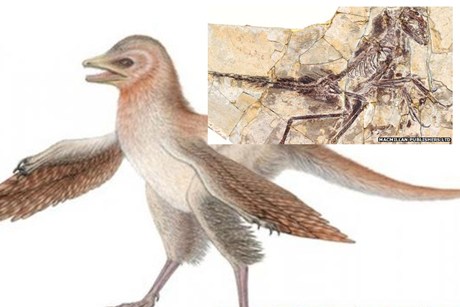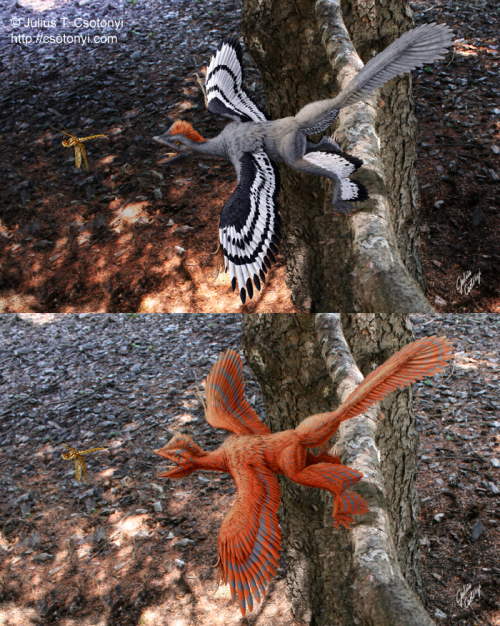A new feathered dinosaur – worth getting ruffled for?
Two new feathered dinosaur articles appeared in the latest edition of Nature Communications; one on gender identification in a well-known theropod (the meat noshing ones), and the subject of a forthcoming blog post, and another on a new feathered fiend from, surprise surprise, China.
I normally really don’t like writing about theropods, especially of the feathered variety, as it just seems like I’m jumping on the bandwagon that they were awesome and every aspect of them needs extensive media coverage. Ok, yeah, they can be pretty cool. But only, for me, in the context of the larger evolutionary patterns that they can reveal to us, such as the evolution of feathers and flight. Each new fossil doesn’t exactly transform our knowledge of this, but they do help us to refine our theories to a certain extent; whether or not that’s worthy of excessive media coverage and Nature publications, is not my judgement to make (no, it’s not).
So yeah, this new paper. Naturally, being in Nature Communications, most of you reading this won’t be able to read the actual article, unless you emailed the author or have an individual or institutional subscription. So here’s the executive summary that apparently warrants enough of a scientific breakthrough to get whapped into Nature Comms: a feathered troodontid (theropod) from the middle-Late Jurassic of China has done absolutely nothing to challenge the currently prevailing hypothesis of the evolution of flight in dinosaurs. What’s that? No, that’s not how the media have been touting this story is it. Why? Because there’s no actual revolutionary or massively progressive science within this paper, or at least nothing deserved of the magnitude of the coverage it received. In my opinion. New fossil species are discovered and published on a daily basis. On the grand scale of things, this new one counts for pretty much nothing. You could probably get away with saying that every fossil found in future has feathers just to get it in a high impact journal. But that would be silly..
So what does the paper and this new species tell us? Well, we have a new species of troodontid (Troodontidae), named Eosinopteryx brevipenna. New genera and species like this are given the suffix gen. et. sp. nov. in the paper they are first named in. In an analysis of the phylogenetic (evolutionary) relationships of Paraves (a group defined as the most-inclusive clade [a group including an ancestor, and all of its descendants] containing Passer domesticus (the house sparrow) but not Oviraptor philoceratops).

The authors do add another page to an ageing, and frankly not very dynamic hypothesis now. Archaeopteryx is a pretty important fossil species, as far as they go. There has been a rather vocal debate though as to whether it is a bird or not though. The current study resolves both Archaeopteryx and Eosinopteryx near the base of a clade called Deinonychosauria, which includes Troodontidae and excludes the bird lineage (Avialae). Frustratingly, and a seemingly increasingly occurring practice, there is no reasoning given why this arbitrary label was applied to this arbitrary node (representing the origin of the clade), and thus any attempt at a meaningful taxonomic statement here is lost by a complete lack of supporting anything.
Interestingly, the new species Eosinopteryx is recovered as the sister species (closest relative) to a certain Anchiornis huxleyi, which a few years ago did help to revolutionise the way in which we interpreted the acquisition of avian or bird-like characteristics and feather development. As such, Eosinopteryx, in the grand scheme of bird evolution tells us very little that Anchiornis hadn’t already divulged to us. One thing of note about this specimen is that the feather structures are more primitive than that found in Anchiornis. This plausibly represents a variation in the mode of life, as is expected and documented throughout the ‘experimental phases’ of feather evolution and the onset of powered flight. It is possible that due to a reduced tail plumage, combined with a lack of ability to move the forearms in a manner that would facilitate flapping, that Eosinopteryx was capable of running (a ‘cursorial’ mode of life). It also reinforces (not revelates) the currently well-established hypothesis that the initial and early development of feathers was not for flight, but more for insulation, display or gliding, not powered flight. It’s quite to cool to cast our minds back, and think that while these early dino-birds were zipping around on the ground, their closest cousins were up in the trees above, gliding from trunk to trunk, or being daredevils and jumping off cliffs, just to see if function and form were indeed correlated. Never a wasted sacrifice.

As a final thought, and following a discussion on Twitter with Brian Switek, Dave Hone, Mike Taylor, and Andy Farke, four awesome palaeontologists and sci comm jedis (a good thing), does anyone know roughly what proportion of all palaeontology-based papers that have appeared in Science and Nature over the last decade or so have been on feathered theropod dinosaurs, and similarly for coverage in the mass media? This would be a really cool meta-analysis to do to see if there is a bias in the coverage of palaeontology and uptake in ‘glamour magazines’ with respect to feathered dinosaurs. It’s just that, on a superficial and anecdotal basis, there seems to be an overwhelming proportion of coverage and ‘high-impact’ publications of pretty much anything to do with a feathered dinosaur; it would be cool to is if this is a genuine thing or just an artefact of, for example, what we pick up through Twitter. If anyone has an idea about how to approach such a project, please do leave a comment or get in touch!
Reference:
Godefroit et al. (2013) Reduced plumage and flight ability of a new Jurassic Paravian theropod from China, Nature Communications, DOI: 10.1038/ncomms2389
Coverage by Brian Switek: http://phenomena.nationalgeographic.com/2013/01/29/tiny-feathery-dinosaur-raises-jurassic-questions/
Coverage on io9: http://io9.com/5979381/this-little-dinosaur-had-feathery-wings-150-million-years-ago++but-definitely-couldnt-fly
Coverage by the BBC: http://www.bbc.co.uk/news/uk-england-hampshire-21181611
Note: One of the authors, Gareth Dyke, has set up an MSc for Vertebrate Palaeontology in Southampton, UK, and has a couple of sweet PhD projects on offer. Worth checking out! He’s also an awesome person, in my little experience, and frighteningly intelligent about bird evolution.
This was original posted at: http://blogs.egu.eu/palaeoblog/2013/01/31/a-new-feathered-dinosaur-worth-getting-ruffled-for/
Aaaw, Anchiornis is my favorite, definitely.
Would you be interested in a paper my husband did on sampling and media reports WRT non-avian dinosaurs? There are a few citations & some data analysis that you might be able to use.
And based on anecdotal evidence from colleagues and my own blog, I’m pretty sure that it’s mostly because feathery freaks are super-sexy and the public respond really well to them!
Anchiornis is certainly an awesome li’l dino 🙂
Yes please!! That would be absolutely awesome! Is the paper freely available?
Sure, it’s here (that should work?) You might be interested in “Colless’s index of phylogenetic tree imbalance” which relates discovered creatures to their impact on their trees.
And here is an amusing Google Trend showing that it’s all pretty recent…
Hmm. Doesn’t seem to be working for me. Would it be ok if you emailed it to jon.tennant.2@gmail.com please? Thanks in advance!! 🙂